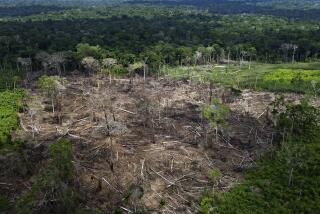BOOK REVIEW : New Hope for Threatened Wildlife : AT THE HAND OF MAN: Peril and Hope for Africa’s Wildlife <i> by Raymond Bonner</i> . Alfred A. Knopf: $24, 320 pages
- Share via
How can man prevent the seemingly imminent destruction of Africa’s magnificent wildlife? By supporting the global ban on the sale of ivory, ending the insidious practice of big-game hunting, creating more parks free of human settlement and patrolling the preserves with paramilitary forces?
These are the standard solutions, conditioned by decades of conservation as practiced in America, where the idea of national parks originated. In Africa, however, these “preservationist” tactics have failed miserably. How, then, can the wildlife survive?
In the four years he spent in Nairobi, Kenya, this question preoccupied Raymond Bonner, a staff writer at the New Yorker and the author of two well-received books on foreign affairs. Bonner crisscrossed the continent searching for programs that worked, looking for hope in the killing fields. He came away an advocate of “sustainable utilization,” the rival to the preservationist school of conservation.
“At the Hand of Man” is bound to offend animal-rights activists and to shock devotees of the Discovery Channel, for Bonner believes in killing individual animals so that entire ecosystems can survive. In these pages, he suggests that the global ban on the ivory trade be lifted, promotes regulated trophy hunting (though he says he could never pull the trigger himself) and derides the conventional notion that parks should prohibit human settlement.
Bonner witnessed multimillion-dollar anti-poaching operations, replete with helicopter gunships, but the successful projects he found were shoestring programs run by local African communities. In the Kaokoveld desert, where the “semi-arid beauty is raw, silent and overpowering” and where white poachers wiped out most of the wildlife in the 1970s, elders of the Himba tribe took matters into their own hands in 1982.
The Himbas’ “community game guard program” was based on the Bible, one village elder tells Bonner. “When God punished the world in the time of Noah, all these wild animals were protected and put on Noah’s Ark. . . . We realized we had to do something . . . . In the old days there were rules. It was not like recent times when everyone was just shooting everything. . . . We decided to work out this plan, so that it would be possible that a family could shoot some animals to eat and the game would still be plentiful.”
The Himbas organized game rangers, enacted a modest tax on tourists to produce revenue for the community and produced crafts to sell to visitors. Poaching stopped. Today, both the people and the wildlife flourish on the Kaokoveld.
In Nyaminyami, Zimbabwe, the only system that prevents farmers from killing animals that threaten their herds is sustainable utilization. Impala herds are culled for protein, concessions to hunt elephants and lions for thousands of dollars per animal are sold and tourism is encouraged. All of the financial returns are plowed back into the community. One of the poorest areas in Zimbabwe, Nyaminyami is becoming one of the wealthiest. And its wildlife is thriving.
Bonner’s behind-the-scenes account of the furor that led to the 1989 global ban on the sale of elephant products (a ban that ignored the protests of a majority of African countries) makes for a fascinating tragicomedy. The World Wildlife Fund and the African Wildlife Foundation grew rich through their slick elephant preservation campaigns; the AWF, for example, quadrupled its $2-million annual budget. While both organizations had been opposed to a total ban (for their field conservationists understood at least some of the merits of sustainable utilization), the success of their campaigns led them to declare the African elephant an endangered species.
“At the Hand of Man” evades a crucial issue: Africa’s exploding population. If the growth is not defused through grass-roots family planning, all conservation will fail. Still, by elucidating the difficult issues of African conservation through entertaining anecdotes and hard facts, Bonner has produced both a thorough review of conservation history and a persuasive argument for sustainable utilization.


